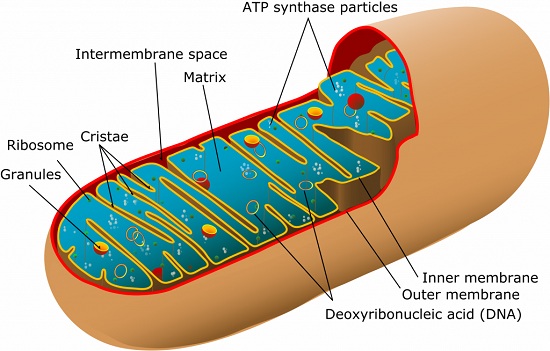- A cell is the basic functional unit of an organism.
Read More On
- The Cell - Introduction to the Cell
- Estimation of the Cell Size - Tissues and Organs in Plants and Animals
- Mitochondrion is a sausage shaped organelle that provides sites for respiratory reactions that yield energy for the cell. Mitochondria is thus, referred to as the powerhouse of the cell.
- It is bound by two membranes. The inner membrane is greatly folded into cristae to increase surface area for respiration.

- Endoplasmic reticulum appears as a series of interconnected channels, running throughout the cytoplasm.
- Their membranes are continuous with the outer membrane of the nuclear membrane.
- Some endoplasmic reticula have granules called ribosomes on their surfaces and are referred to as rough or granular endoplasmic reticula.
- Endoplasmic reticula that are not associated with ribosomes are called smooth endoplasmic reticula.
- These are spherical in shape. While some are bound to the endoplasmic reticula, some ribosomes are scattered within the cytoplasm (free ribosomes). Their largest dimension is 25 nanometres.
- They are synthesised in the nucleolus.
- They form sites for protein synthesis.
- These are spherical sac-like organelles bound by a single membrane. They contain lytic enzymes which break down large molecules, destroy worn out organelles or even the entire cells.
- Lysosomes also play crucial role in digestion in unicellular organisms.
- The lysosomes are also vital in breakdown of bacteria and other harmful microbes that might have been ingested in food. This explains their high relative abundance in injured or infected cells.
- The membrane of the lysosomes are intact. This is important because if the enzymes leak out, they may destroy the whole cell.
Nucleus is a double membrane bound structure made up of a viscous fluid known as nucleoplasm in which nucleolus and chromatin materials are suspended. The nuclear membrane has minute pores, nuclear pores which allow materials to move in and out of the nucleus.
- Nucleus controls all the activities of the cell.| Plants | Animals |
|---|---|
| Usually Large | Smaller in Size |
| Regular in shape | Irregular in shape |
| Has a cell wall | Has no cell wall |
| Usually has a large vacuole | Usually has no vacuole but when present, they are often temporary and small structures within the cytoplasm |
| Cytoplasm and Nucleus are usually located towards the periphery of the cell | Cytoplasm occupies most space in the cell with the nucleus usually centrally placed |
| Some have chloroplasts | Has no chloroplasts |
| Usually most store oils, starch and proteins | Store glycogen and fats |
| Has no centriole | Has centrioles |